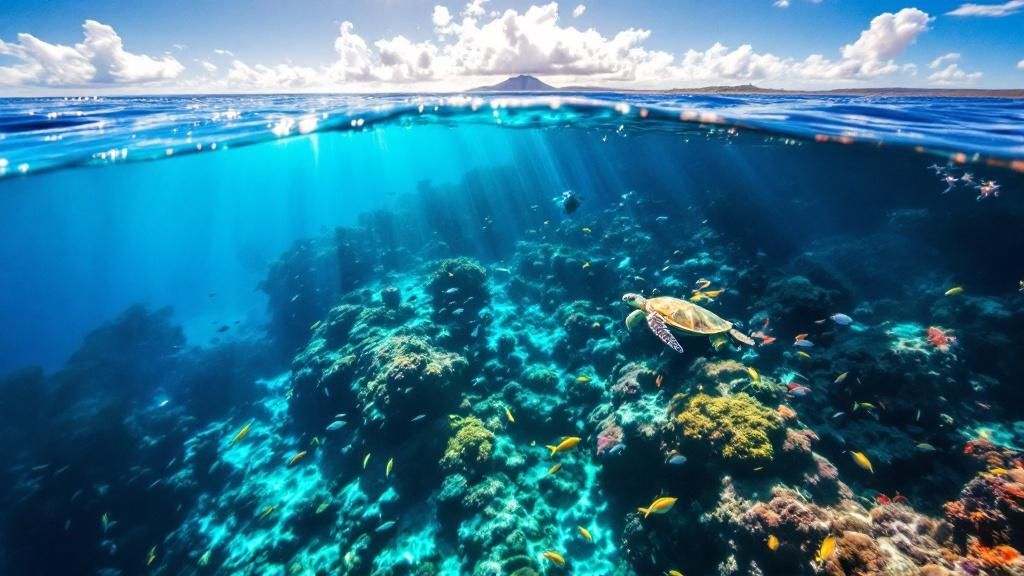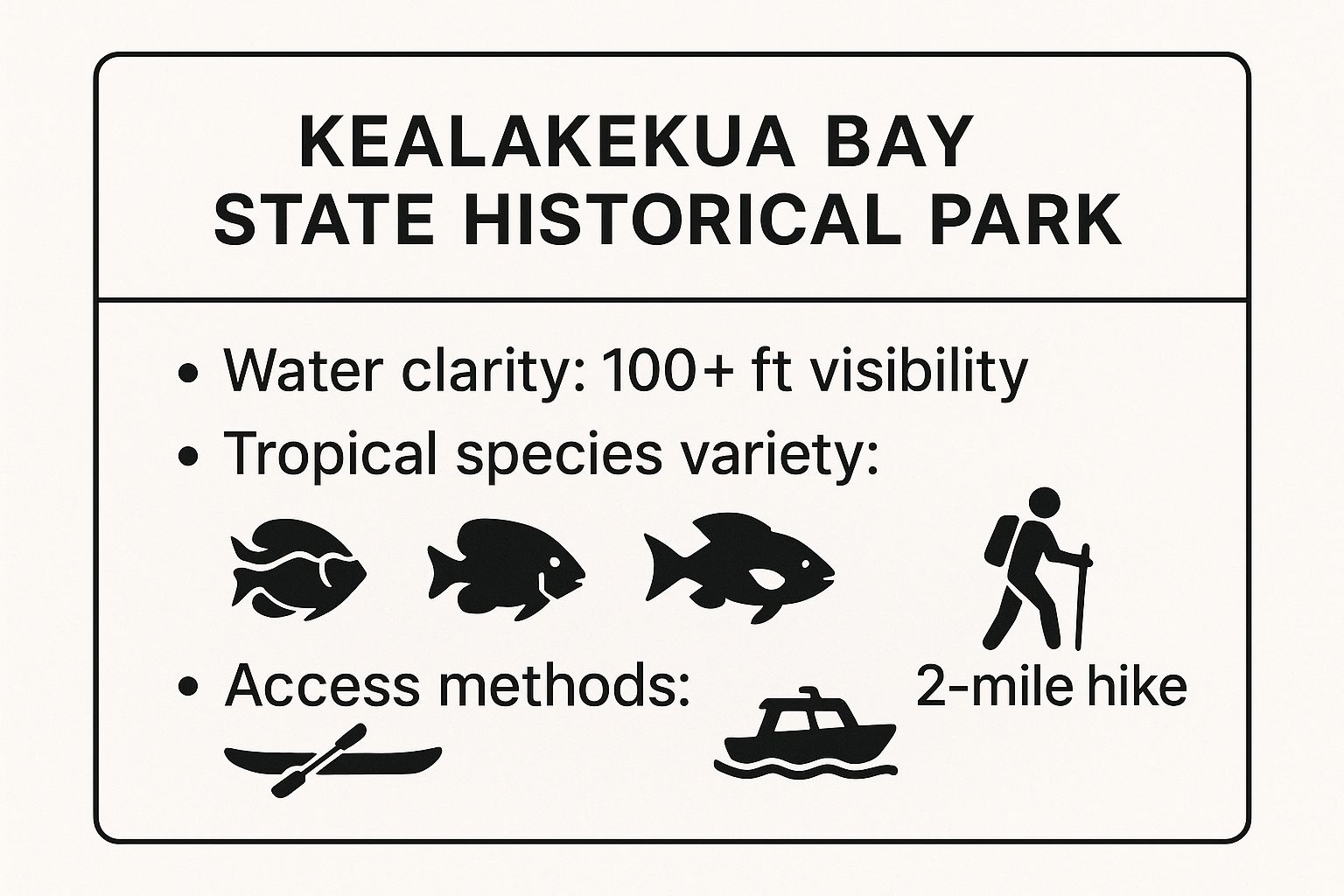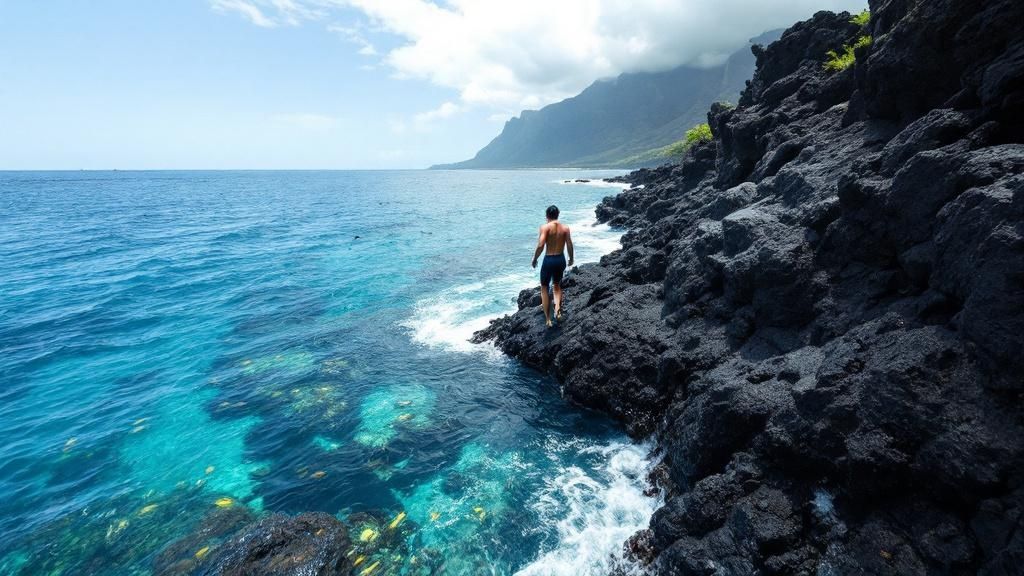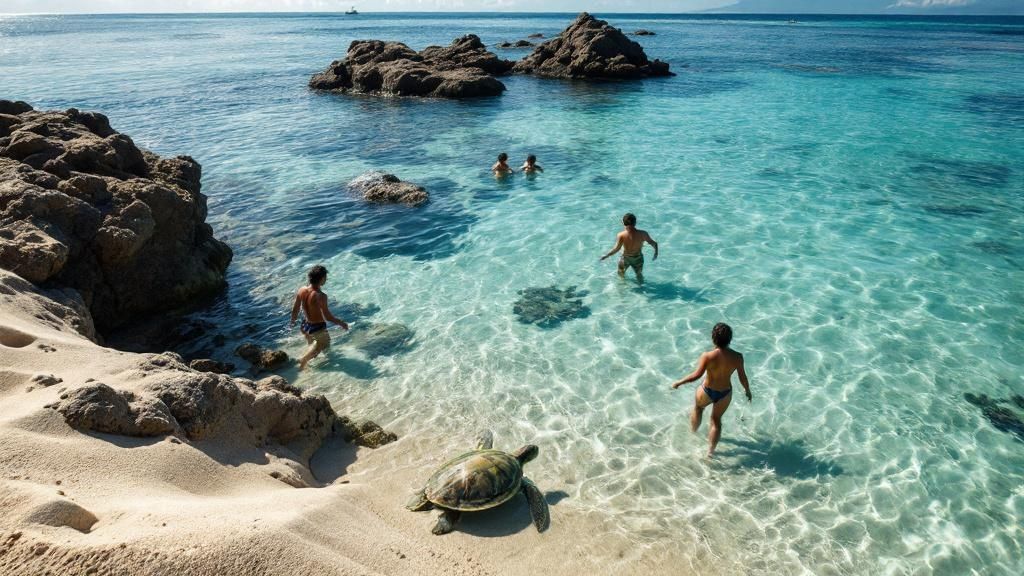Top 6 Spots for the Best Snorkeling in Kona HI (2025 Guide)

The Kona coast of Hawaii's Big Island is a world-renowned paradise, but its true magic lies just beneath the waves. The crystal-clear, protected waters are a sanctuary for vibrant coral reefs, a dazzling array of tropical fish, and majestic marine life like green sea turtles and graceful manta rays. Planning the perfect underwater adventure here can feel overwhelming with so many incredible options available.
This guide cuts through the noise, offering a detailed roundup of the absolute best snorkeling in Kona HI. We'll explore six top-tier locations, from iconic, protected bays like Kealakekua Bay to easily accessible local gems like Kahalu'u Beach Park. We provide the essential details you need for a successful trip: access methods, what marine life you can expect to see, and insider tips to maximize your time in the water.
Whether you are a first-time snorkeler or a seasoned free-diver, this article will help you plan an unforgettable experience. As you prepare to immerse yourself in Kona's stunning underwater landscapes, consider how supporting the 5 For Oceans initiative is vital for preserving these pristine sites for generations to come. We will also highlight how professional tours can elevate your adventure by providing safe, guided access to premier spots that are otherwise difficult to reach.
1. Kealakekua Bay State Historical Park: The Crown Jewel of Kona
When discussing the best snorkeling in Kona, HI, one location consistently rises to the top: Kealakekua Bay. This isn't just another pretty spot; it's a designated Marine Life Conservation District (MLCD), offering a pristine underwater ecosystem that sets the standard for the entire island. Sheltered by dramatic, ancient lava rock cliffs, the bay's waters are typically calm and exceptionally clear, creating ideal conditions for snorkelers of all skill levels.
The bay’s unique geography protects a vibrant coral reef system teeming with life. Its historical importance is just as profound. This is the very site where British explorer Captain James Cook first landed on the island in 1779, and ultimately, where he was killed. A prominent white obelisk, the Captain Cook Monument, marks the location on the shore, adding a layer of historical weight to your aquatic adventure.
Why It’s a Top Snorkeling Destination
Kealakekua Bay offers an unparalleled combination of water clarity, marine biodiversity, and historical significance. The calm, protected waters act as a natural aquarium, allowing for easy viewing of spinner dolphins, sea turtles, and a dazzling array of tropical fish. Its status as a conservation district means the reef is healthier and more vibrant than in many other coastal areas.
Expert Insight: The bay's protected status is crucial. Because fishing is heavily restricted and anchoring is prohibited in much of the area, the coral gardens have been allowed to flourish, supporting a dense and diverse fish population rarely seen elsewhere.
For a quick reference, this summary box highlights the key features that make Kealakekua Bay a premier snorkeling destination.

The incredible visibility and diverse access methods make it clear why this location is a must-visit for any Kona snorkeling trip.
Practical Tips for Your Visit
Reaching the prime snorkeling area near the monument requires some planning, as there is no direct road access.
- Book a Tour: The easiest and most recommended method is to join a guided boat or kayak tour. Companies like Kona Snorkel Trips provide not only the gear and transportation but also invaluable historical context and expert guidance to the best spots.
- Go Early: Aim for an early morning excursion. You’ll beat the afternoon winds that can make the water choppy and avoid the peak crowds.
- Pack Smart: There are no facilities (restrooms, food, or water) at the monument. Bring everything you need, including plenty of water, snacks, and reef-safe sunscreen to protect the fragile coral.
- Check Conditions: Always review the marine weather forecast before heading out, especially if you plan to kayak independently across the bay. Safety should always be your top priority.
2. Honaunau Bay (Two Step): The Local's Favorite
Just south of Kealakekua Bay lies Honaunau Bay, affectionately known as "Two Step." This spot is a perennial favorite for both local residents and seasoned snorkelers, famed for its incredibly convenient shore access and abundant marine life. Its nickname comes from a natural, smooth lava rock formation that provides a perfect two-step entry point directly into the clear, deep water, bypassing the need to navigate a sandy or rocky shoreline.
Honaunau Bay sits adjacent to the historically significant Puʻuhonua o Hōnaunau National Historical Park, a sacred place of refuge in ancient Hawaiian culture. This cultural backdrop adds a profound sense of place to the underwater exploration. The bay itself is a vibrant aquatic ecosystem where coral gardens thrive just a few kicks from shore, making it one of the premier destinations for anyone seeking the best snorkeling in Kona, HI, without needing a boat.

Why It’s a Top Snorkeling Destination
Two Step offers a unique blend of easy access, excellent visibility, and diverse marine encounters. Unlike more remote spots, you can simply park your car and be in the water within minutes. The bay’s structure provides a shallow, protected area perfect for beginners, while the outer bay drops off quickly, attracting larger marine life for more advanced snorkelers.
It's a world-renowned location for encountering spinner dolphins in the morning and is a primary research site for organizations like Manta Ray Advocates. Underwater photographers and videographers flock here to document the rich biodiversity, including the possibility of spotting manta rays or even whale sharks during their respective seasons.
Expert Insight: The real magic of Two Step is its accessibility to depth. You don't need a boat to access deep water where pelagic species might cruise by. This makes it one of the few places on the island where you have a legitimate chance of a "big animal" encounter right from the shore.
The bay’s reputation as a top-tier shore-entry snorkel and dive site is well-deserved, as you can see from the variety of life just below the surface.
Practical Tips for Your Visit
While access is easy, a little preparation will make your visit to Two Step safer and more enjoyable.
- Arrive Early: The small parking area fills up quickly, especially on weekends and holidays. An early start ensures you get a spot and experience the calmest water conditions before the afternoon winds pick up.
- Gear Up: Wear water shoes or booties. The lava rock is sharp and can be slippery, so proper footwear is essential for safely navigating the entry and exit points.
- Respect the Area: Only use the designated "two step" lava shelf for entry and exit to protect the fragile coral in the shallower areas. Remember you are a guest in a culturally significant place.
- Check Conditions: The bay is generally protected, but open ocean swells can create hazardous conditions. Always check the surf report before getting in the water. For more information, review these essential snorkeling safety tips.
3. Kahalu'u Beach Park: The Ultimate Beginner’s Paradise
For families, first-time snorkelers, or anyone seeking a relaxed and accessible underwater experience, Kahalu'u Beach Park is a true gem. This protected bay is renowned for its calm, shallow waters and incredibly easy beach entry, making it one of the most popular spots for the best snorkeling in Kona, HI. The bay is partially sheltered from the open ocean by a man-made breakwater, a remnant of an ancient Hawaiian breakwater (kuapā), which creates a safe, pool-like environment perfect for all ages.
The park isn't just a recreational spot; it's a significant cultural and ecological site. The calm waters have fostered a resilient coral reef ecosystem that starts just feet from the shore. This proximity allows even the most hesitant swimmer to witness a stunning variety of marine life without venturing into deep water.

Why It’s a Top Snorkeling Destination
Kahalu'u Beach Park stands out for its unmatched accessibility and concentrated marine biodiversity. It is one of the few places on the island where you can simply walk into the water from a sandy patch and be surrounded by colorful fish within seconds. The bay is a frequent resting spot for Hawaiian green sea turtles (honu), offering near-guaranteed sightings.
Expert Insight: The presence of on-site "Reef Teach" volunteers is a unique asset. These dedicated educators provide free information about the bay's delicate ecosystem, proper reef etiquette, and how to safely interact with wildlife, enhancing both the safety and educational value of your visit.
For a quick reference, this summary box highlights the key features that make Kahalu'u Beach Park a premier snorkeling destination.
The incredible ease of access and the dense fish population make it clear why this location is a must-visit, especially for those new to the world of snorkeling. Its calm conditions are also ideal for those wanting to practice their skills, such as learning how to take great underwater pictures.
Practical Tips for Your Visit
To make the most of your trip to this popular park, a little planning goes a long way.
- Arrive Early: The parking lot is notoriously small and fills up fast, especially on weekends and during peak season. Aim to get there before 9 AM to secure a spot and enjoy the water before the crowds arrive.
- Bring Reef Shoes: While there is a sandy entry point, much of the bay floor is covered in lava rock and coral. Water shoes or reef walkers will protect your feet and make exploring much more comfortable.
- Respect the Honu: You will almost certainly see sea turtles. It is a magical experience, but remember they are protected. Maintain a respectful distance of at least 10 feet (3 meters) and never touch or chase them.
- Use Reef-Safe Sunscreen: The coral here is fragile. Please apply reef-safe sunscreen at least 20 minutes before entering the water to help protect this precious underwater environment for future generations.
4. Kailua-Kona Pier and Kamakahonu Beach: An Urban Underwater Surprise
You don't always have to travel far for some of the best snorkeling in Kona, HI. Located right in the heart of historic Kailua-Kona town, the Kailua-Kona Pier and the adjacent Kamakahonu Beach offer a surprisingly vibrant and accessible underwater experience. This urban snorkeling spot proves that incredible marine life can thrive just steps from the town's bustling streets.
Kamakahonu Beach, also known as King Kam Beach, is a small, protected cove with calm, shallow waters, making it ideal for beginners and families. The real treasure, however, lies around the pier itself. The underwater structures of the pier have become an artificial reef, attracting a diverse community of fish and, most notably, frequent green sea turtle visitors who come to rest and feed in the protected area.
Why It’s a Top Snorkeling Destination
The combination of extreme convenience and rich marine life makes this a standout location. Its central location means you can easily fit a snorkeling session into a day of exploring Kailua-Kona's shops, restaurants, and historical sites. It’s also the famous starting point for the Ironman World Championship swim, adding a unique athletic history to the site.
Expert Insight: The pier's pilings and the nearby rocky shoreline create micro-habitats that shelter a surprising variety of species. It's a prime example of how urban structures can coexist with and support a healthy marine ecosystem, offering a unique snorkeling environment you won't find in more remote bays.
This spot is perfect for a spontaneous snorkel or for those who want to introduce children to the activity in a safe, controlled environment. The easy entry and exit from the sandy beach remove many of the barriers associated with more rugged, remote locations. With so many colorful fish to see, you'll want to be able to identify them; this handy Hawaiian fish identification guide can help you name the species you encounter.
Practical Tips for Your Visit
To get the most out of this urban snorkeling gem, a little timing and awareness go a long way.
- Mind the Boat Traffic: The pier is an active hub for tour boats and local fishermen. For the best and safest experience, snorkel in the early morning before most tours depart or in the late afternoon after they have returned.
- Explore the Structures: The most abundant sea life is found around the pier's pilings and the rocky edges of the bay. Swim parallel to the shore and pier, but always stay aware of your surroundings and any boat activity.
- Respect Cultural Sites: Kamakahonu Beach is adjacent to the Ahuʻena Heiau, a reconstructed temple and a significant cultural site. Be respectful of the area's historical importance both in and out of the water.
- Check Water Clarity: As an urban spot, water clarity can sometimes be affected by runoff after heavy rains. Conditions are typically excellent, but it's always good practice to take a quick look before getting in.
5. Kona Coast State Park (Kekaha Kai): A Pristine Escape
For those seeking a more rugged and secluded snorkeling adventure, Kona Coast State Park, also known as Kekaha Kai, offers an unspoiled slice of paradise. This park is a collection of stunning white sand beaches and crystal-clear bays, a world away from the more developed resort areas. Its relative isolation means fewer crowds and a more intimate connection with nature, making it a favorite for locals and in-the-know visitors.
The park encompasses three distinct areas, with Mahai'ula Bay and Kua Bay (Manini'owali Beach) being the most popular for snorkelers. Each bay presents a unique landscape, from the expansive sands of Mahai'ula to the picturesque cove of Kua Bay. The journey to get here is part of the experience, requiring a drive over an unpaved road that rewards intrepid travelers with some of the most beautiful and tranquil waters in Kona.
Why It’s a Top Snorkeling Destination
Kekaha Kai provides a raw, natural snorkeling experience defined by its incredible water clarity and pristine conditions. The park’s less-trafficked nature helps preserve the delicate marine environment, allowing snorkelers to explore healthy coral formations and a diverse range of fish without navigating large crowds. It’s the perfect spot for those who want to feel like they’ve discovered a hidden gem.
Expert Insight: The park’s access road deters many, which is precisely what keeps it so special. The reward for navigating the bumpy, 1.5-mile lava rock road to Mahai'ula Bay is a nearly private snorkeling experience, especially on weekdays. The calmer conditions are typically found along the rocky outcrops on either side of the beaches.
The combination of seclusion, stunning scenery, and vibrant underwater life makes Kekaha Kai a standout destination for those looking for the best snorkeling in Kona, HI, off the beaten path. For a visual guide to its location relative to other top spots, you can review a detailed Big Island snorkeling map.
Practical Tips for Your Visit
Success at Kekaha Kai hinges on preparation, as there are minimal to no facilities available.
- Vehicle Choice: A high-clearance vehicle (like an SUV or Jeep) is highly recommended for the unpaved road to Mahai'ula. The road to Kua Bay is paved but can get very crowded.
- Pack Everything: Bring all necessary supplies, including ample water, food, towels, and shade (like an umbrella), as there is little natural cover.
- Check the Surf: Kua Bay, in particular, can have strong surf and shore break, especially during winter months. Always check ocean conditions before getting in the water.
- Wear Reef Shoes: The entry points can be rocky, and lava rock is sharp. Reef shoes will protect your feet and make getting in and out of the water much easier.
- Arrive Early: Get there in the morning to secure parking (especially at Kua Bay), avoid the midday heat, and enjoy the calmest water conditions before the afternoon winds pick up.
6. Lapakahi State Historical Park: A Journey Through History and Under the Sea
For those who want to blend a rich cultural experience with their underwater adventure, Lapakahi State Historical Park offers a truly unique opportunity. Located in the North Kohala district, this park is not just a snorkeling spot but also a partially restored ancient Hawaiian fishing village. It provides a fascinating look into the traditional ahupuaʻa (land division) that sustained life for centuries, all while offering excellent snorkeling just offshore.
The park’s coastline is a mix of coral rubble and lava rock, leading to clear and generally calm waters protected within Koaiʻe Cove. This setting allows snorkelers to explore a healthy marine environment while being surrounded by the tangible history of an ancient settlement. It’s a place where you can walk through the remnants of homes and religious sites before slipping into the water to see the same marine life that the villagers depended on.
Why It’s a Top Snorkeling Destination
Lapakahi State Historical Park stands out by offering a dual experience: historical education and quality snorkeling. The cove’s protected nature makes it accessible for most skill levels, and its designation as a Marine Life Conservation District (MLCD) ensures the underwater ecosystem is thriving. You can expect to see vibrant coral gardens and a healthy population of reef fish in a location that feels a world away from the bustling resorts.
Expert Insight: The historical context profoundly enhances the snorkeling here. Knowing you are swimming in the same waters where ancient Hawaiians launched their fishing canoes adds a layer of respect and wonder to the experience. The MLCD status means the fish are more abundant and less shy, offering incredible up-close encounters.
This combination of history and marine life makes Lapakahi a standout choice for an enriching day trip. While it doesn't have the dramatic cliffs of other spots, its cultural significance and healthy reef make it a compelling destination for those seeking more than just a pretty view. The underwater topography here is fascinating, creating diverse habitats that attract a wide array of species, similar to what you might find at other lesser-known gems. For more on these kinds of unique environments, you can explore the diverse marine life in Kona's bays.
Practical Tips for Your Visit
A successful trip to Lapakahi requires a bit of preparation, as the park is rustic and focuses on preservation over amenities.
- Combine Activities: Plan to spend time exploring the self-guided trail through the historical village site before or after you snorkel. The interpretive signs provide valuable context about what you're seeing.
- Wear Sturdy Footwear: The shoreline is rocky and uneven. Water shoes or dive booties are essential for safely entering and exiting the water.
- Check Park Hours: As a state historical park, Lapakahi has specific operating hours and can occasionally close for cultural events or maintenance. Always verify it's open before you make the drive.
- Pack Accordingly: There are minimal facilities on-site. Bring your own water, snacks, and reef-safe sunscreen, as there is little shade and you'll want to protect the very ecosystem you’re there to enjoy.
Top 6 Kona Snorkeling Spots Comparison
| Location | Implementation Complexity 🔄 | Resource Requirements ⚡ | Expected Outcomes 📊 | Ideal Use Cases 💡 | Key Advantages ⭐ |
|---|---|---|---|---|---|
| Kealakekua Bay State Historical Park | Moderate (kayak/boat/hike access) | Moderate (kayak/boat rental, gear) | High marine biodiversity, excellent visibility | Beginner to advanced snorkelers, historical interest | Pristine reefs, calm waters, cultural value |
| Honaunau Bay (Two Step) | Moderate (shore entry but rocky) | Low (free shore access, reef shoes) | Frequent sightings of large marine life (manta rays) | Intermediate to advanced snorkelers, night snorkeling | Easy deep water access, less crowded |
| Kahalu'u Beach Park | Low (easy sandy beach entry) | Low (basic gear, parking) | Good for beginners, abundant sea turtles | Families, beginners, educational tours | Calm shallow waters, full facilities |
| Kailua-Kona Pier & Kamakahonu Beach | Low (urban, direct beach access) | Low (easy access, nearby amenities) | Moderate diversity, frequent sea turtles | Urban snorkelers, beginners, easy access | Convenient location, calm waters |
| Kona Coast State Park (Kekaha Kai) | High (rough dirt road, remote) | High (4WD vehicle, supplies needed) | Pristine, uncrowded snorkeling with diverse marine life | Intermediate snorkelers, adventure seekers | Multiple bays, excellent clarity |
| Lapakahi State Historical Park | Moderate (rocky shore access) | Low to Moderate (protective footwear) | Cultural and marine exploration, calm clear water | Intermediate snorkelers, culture enthusiasts | Combines history with snorkeling, less crowded |
Choosing Your Perfect Kona Snorkeling Adventure
The Kona coast unfolds like an underwater map, with each destination offering a distinct chapter in Hawaii's vibrant marine story. From the sacred, protected waters of Kealakekua Bay, teeming with life, to the easy, family-friendly entry at Kahalu'u Beach Park, you now have the insights to choose an adventure that perfectly matches your skill level and sense of wonder. The "best snorkeling in Kona HI" isn't a single location; it’s the one that delivers the experience you are seeking.
Whether you're carefully navigating the lava rock entry at Honaunau Bay (Two Step) or discovering the hidden gems along the rugged shores of Kona Coast State Park, your preparation is key. Understanding the access, the typical conditions, and the unique marine life at each spot transforms a simple swim into a profound connection with the ocean.
Key Takeaways for Your Kona Snorkel Plan
To make the most of your time in the water, keep these crucial points in mind:
- Match the Spot to Your Skill: First-timers and families will thrive at Kahalu'u Beach Park, while confident swimmers seeking a richer historical context will find Kealakekua Bay and Lapakahi State Historical Park deeply rewarding.
- Logistics Matter: Some of the most pristine locations, like Kealakekua Bay, are best reached via a guided boat tour. This not only solves the difficult access but also enhances the experience with expert knowledge and top-tier equipment.
- Respect the ‘Aina (Land) and Kai (Sea): Your actions have a direct impact. Always use reef-safe sunscreen, maintain a safe distance from all marine life (especially turtles and dolphins), and never touch or stand on the delicate coral reef.
Prioritizing Safety and Preparedness
A safe adventure is a successful adventure. Always snorkel with a buddy, check ocean conditions before you enter the water, and be aware of your surroundings. Being prepared for unexpected situations is just as important as packing your fins. Beyond general first aid, knowing specific life-saving techniques can make a big difference, especially with water activities. Learn how to help someone choking to ensure you have the confidence to act in an emergency.
Kona’s underwater world is a gift. It's a living, breathing ecosystem that has captivated visitors for generations. By choosing your locations wisely, preparing thoroughly, and snorkeling responsibly, you are not just a visitor; you become a temporary guardian of this incredible paradise. The vibrant fish, the graceful sea turtles, and the ancient coral gardens are waiting. Go discover them.
Ready to experience Kona's premier snorkeling without the guesswork? Let the experts at Kona Snorkel Trips guide you to the most spectacular underwater sites, including the world-famous manta ray night snorkel. Book your unforgettable adventure today and let us handle all the details.
